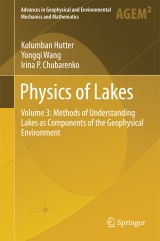Details

Physics of Lakes
Volume 3: Methods of Understanding Lakes as Components of the Geophysical EnvironmentAdvances in Geophysical and Environmental Mechanics and Mathematics
|
149,79 € |
|
| Verlag: | Springer |
| Format: | |
| Veröffentl.: | 26.03.2014 |
| ISBN/EAN: | 9783319004730 |
| Sprache: | englisch |
Dieses eBook enthält ein Wasserzeichen.
Beschreibungen
The ongoing thread in this volume of Physics of Lakes is the presentation of different methods of investigation for processes taking place in real lakes with a view to understanding lakes as components of the geophysical environment. It is divided into three parts. Part I is devoted to numerical modeling techniques and demonstrates that (i) wind-induced currents in depth-integrated models can only adequately predict current fields for extremely shallow lakes, and (ii) that classical multi-layered simulation models can only adequately reproduce current and temperature distributions when the lake is directly subjected to wind, but not the post-wind oscillating response. This makes shock capturing discretization techniques and Mellor-Yamada turbulence closure schemes necessary, as well as extremely high grid resolution to reduce the excessive numerical diffusion. Part II is devoted to the presentation of principles of observation and laboratory experimental procedures. It details the principles of operation for current, temperature, conductivity and other sensors applied in the field. It also discusses the advantages and limitations of common measuring methods like registration from stationary or drifting buoys, sounding and profiling from a boat, etc. Questions of data accuracy, quality, and reliability are also addressed. The use of laboratory experiments on a rotating platform is based on an exposition of dimensional analysis and model theory and illustrated using Lake Constance as an example. Part III gives an account of the dynamics of lake water as a particle-laden fluid, which, coupled with the transport of the bottom sediments, leads to morphodynamic changes of the bathymetry in estuarine and possibly whole lake regions. An elegant spatially one-dimensional theory makes it possible to derive analytic solutions of deltaic formations which are corroborated by laboratory experiments. A full three-dimensional description of the evolution of the alluvial bathymetryunder prescribed tributary sediment input indicates a potential subject for future research.
Barotropic Wind-induced Motions in a Shallow Lake.- Response of a Stratified Alpine Lake to External Wind Fields – Numerical Prediction and Comparison with Field Observations.- Comparing Numerical Methods for Convectively-Dominated Problems.- Comparing Different Numerical Treatments of Advection Terms for Wind-Induced Circulations in Lakes.- Subgrid-Scale Parameterization in Numerical Simulations of Lake Circulation.- Instruments and Sensors.- Measuring Methods and Techniques.- Dimensional Analysis, Similitude and Model Experiments.- Prograding and Retrograding Hypo- and Hyperpycnal Deltaic Formations into Quiescent Ambients.- Sediment Transport in Alluvial Systems.
The ongoing thread in this volume of Physics of Lakes is the presentation of different methods of investigation for processes taking place in real lakes with a view to understanding lakes as components of the geophysical environment. It is divided into three parts. Part I is devoted to numerical modeling techniques and demonstrates that (i) wind-induced currents in depth-integrated models can only adequately predict current fields for extremely shallow lakes, and (ii) that classical multi-layered simulation models can only adequately reproduce current and temperature distributions when the lake is directly subjected to wind, but not the post-wind oscillating response. This makes shock capturing discretization techniques and Mellor-Yamada turbulence closure schemes necessary, as well as extremely high grid resolution to reduce the excessive numerical diffusion. Part II is devoted to the presentation of principles of observation and laboratory experimental procedures. It details the principles of operation for current, temperature, conductivity and other sensors applied in the field. It also discusses the advantages and limitations of common measuring methods like registration from stationary or drifting buoys, sounding and profiling from a boat, etc. Questions of data accuracy, quality, and reliability are also addressed. The use of laboratory experiments on a rotating platform is based on an exposition of dimensional analysis and model theory and illustrated using Lake Constance as an example. Part III gives an account of the dynamics of lake water as a particle-laden fluid, which, coupled with the transport of the bottom sediments, leads to morphodynamic changes of the bathymetry in estuarine and possibly whole lake regions. An elegant spatially one-dimensional theory makes it possible to derive analytic solutions of deltaic formations which are corroborated by laboratory experiments. A full three-dimensional description of the evolution of the alluvial bathymetryunder prescribed tributary sediment input indicates a potential subject for future research.
This book, together with vols. 1 and 2, is the first to provide an encyclopedic view of fundamental physical limnology up to 2012 The ideal resource for graduate courses in physical oceanography and limnology Provides in-depth information on theoretical, experimental (laboratory and field) techniques for water and sediment motion in lakes Includes supplementary material: sn.pub/extras
Diese Produkte könnten Sie auch interessieren:

Contaminated Soils, Sediments and Water:

von: Edward J. Calabrese, Paul T. Kostecki, James Dragun

149,79 €















